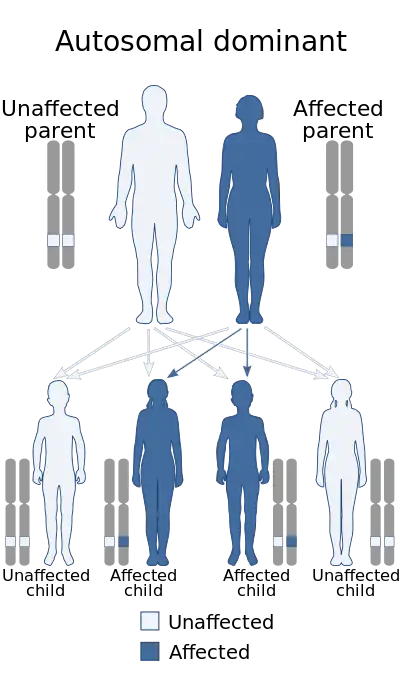Familial multiple cafe-au-lait spots
Familial multiple cafe au lait spots, also known as Autosomal dominant multiple cafe au lait spots or Neurofibromatosis type 6,[2] is a rare, cutaneous genetic disorder which is characterized by the hereditary cutaneous presence of several cafe-au-lait spots without any other symptoms of neurofibromatosis.[3] Sporadic cases may be called "Sporadic multiple cafe au lait spots". Few cases have been described in medical literature, although it is estimated that the presence of multiple cafe au lait spots without NF1 is rare (but not extremely rare) among the general population.[4]
| Familial multiple cafe-au-lait spots | |
|---|---|
| Other names | Neurofibromatosis type 6, Autosomal dominant multiple cafe au lait spots, familial cafe au lait spots[1] |
 | |
| Specialty | Medical genetics, Dermatology |
| Causes | Genetic mutation |
| Prevention | none |
| Prognosis | Good |
| Frequency | Unknown, although a small number of families have been officially described in medical literature, it doesn't mean that there aren't any more families with this disorder in the world. |
| Deaths | - |
History
It was first discovered when Riccardi et al. described multiple families with cafe-au-lait spots and no association for neurofibromatosis in 1980.[5]
In 1993, Charrow et al. described 5 members from a 4-generation family, these members had the characteristic tell-tale sign of neurofibromatosis, multiple cafe au lait spots, however, testing of the gene usually involved in neurofibromatosis revealed it to be normal. They proposed the name for this condition.[6]
In 1993, Brunner et al. tested the NF1 locus on a small 2-generation family with MCALS affecting 3 of its members (a woman and her two daughters), and they found that the woman and her daughters had a mutation in the same NF1 locus that was different from the one that causes neurofibromatosis type I itself.[7]
In 1994, Arnsmeier et al. described twelve patients from three un-related families, one of the families had axillary and inguinal freckles and Lisch nodes. All three families had no other signs of Neurofibromatosis type I.[8]
References
- "Multiple café-au-lait spots". 16 June 2022.
- Madson, Justin G. (2012-05-15). "Multiple or familial café-au-lait spots is neurofibromatosis type 6: clarification of a diagnosis". Dermatology Online Journal. 18 (5): 4. doi:10.5070/D33D56C2Q8. ISSN 1087-2108. PMID 22630574.
- RESERVED, INSERM US14-- ALL RIGHTS. "Orphanet: Familial cafe au lait spots". www.orpha.net. Retrieved 2022-06-02.
- "OMIM Entry - 114030 - CAFE-AU-LAIT SPOTS, MULTIPLE". omim.org. Retrieved 2022-06-02.
- Riccardi, V. M. (1980). "Pathophysiology of neurofibromatosis. IV. Dermatologic insights into heterogeneity and pathogenesis". Journal of the American Academy of Dermatology. 3 (2): 157–166. doi:10.1016/S0190-9622(80)80254-4. ISSN 0190-9622. PMID 6774000.
- Charrow, J.; Listernick, R.; Ward, K. (1993-03-01). "Autosomal dominant multiple café-au-lait spots and neurofibromatosis-1: evidence of non-linkage". American Journal of Medical Genetics. 45 (5): 606–608. doi:10.1002/ajmg.1320450518. ISSN 0148-7299. PMID 8456833.
- Brunner, H. G.; Hulsebos, T.; Steijlen, P. M.; der Kinderen, D. J.; vd Steen, A.; Hamel, B. C. (1993-06-01). "Exclusion of the neurofibromatosis 1 locus in a family with inherited café-au-lait spots". American Journal of Medical Genetics. 46 (4): 472–474. doi:10.1002/ajmg.1320460428. ISSN 0148-7299. PMID 8357027.
- Arnsmeier, S. L.; Riccardi, V. M.; Paller, A. S. (1994). "Familial multiple cafe au lait spots". Archives of Dermatology. 130 (11): 1425–1426. doi:10.1001/archderm.1994.01690110091015. ISSN 0003-987X. PMID 7979446.